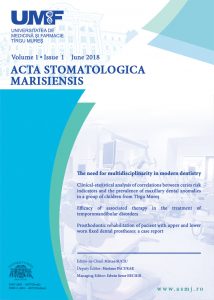Background/Aim: Thorough knowledge of the endodontic anatomy and comprehensive understanding of root canal morphological variations are mandatory to ensure the successful outcome of the endodontic treatment. The purpose of this study was to compare the number of root canals of first and second lower premolars in a selected population to the root canal pattern reported by endodontic literature and to analyze the gender distribution.
Material and methods: A total of 376 preoperative periapical radiographs were obtained from patients living in the Mureș County of Romania. The X-rays were analyzed by 3 endodontists into determining whether the mandibular premolars had one, two or three root canals. The difference between male and female gender distribution was also examined. Endodontic treatment was then performed using the operating microscope to confirm the root canal configuration of the radiographic analysis. The results were compared to common knowledge of the endodontic literature.
Results: In this study, by using the radiographic method combined with direct observation aided by the operating microscope, 31.3% of first premolars and 14.6% of second premolars were found to have two root canals. A higher percentage of two root canals were found in females for both first (60.97%) and second premolars (76.9%).
Conclusion: In the Mureș County region, mandibular premolars with two root canals have a significantly higher rate than the literature reports. Female patients have a higher prevalence than male patients. This should concern clinicians from this area to be aware of these facts as it can unquestionably influence the tooth’s long-term prognosis.
Timea Dakó 1, Ramona-Elena Vlad 1, Alexandra-Mihaela Stoica 1, Andrea-Csinszka Kovàcs-Ivàcson 1, Monica Monea 1
1 George Emil Palade University of Medicine, Pharmacy, Science, and Technology of Târgu-Mureș, Romania
1 George Emil Palade University of Medicine, Pharmacy, Science, and Technology of Târgu-Mureș, Romania

Comments are closed.